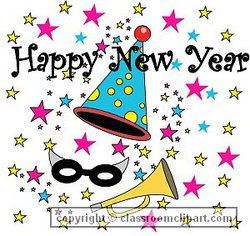New Year's Eve
|
|
New Year's Eve is a celebration held the day before New Year's Day, on December 31, the final day of the year. (See New Year for a discussion of the calendric, religious, and cultural observance of a change of year.)
New Year's Eve is a separate observance from the observance of New Year's Day. In 20th century Western practice, the celebration involves partying until the moment of the transition of the year, generally at local midnight. Drinking champagne is also a major part of the festivities.
Within many cultures the use of fireworks and other noise making is a major part of the celebration in cities such as Sydney, Paris and London.
New Year's Eve is a public non-working holiday in the following countries, among others: Argentina, Brazil, Germany, the Philippines, New Zealand, Australia and Venezuela.
| Contents |
Localized celebrations
Australia
A large number of fireworks are usually set off from the Sydney Harbour Bridge and various spots around Sydney Harbour.
United Kingdom
100,000 people gather for an organised hogmanay street party in Edinburgh, with fireworks being set off from the castle and other major hills around the city. In London, a fireworks display is held around the London Eye. Bideford in North Devon is also famous for its New Years celebrations.
United States
For about four decades Guy Lombardo and his Royal Canadians would serenade the United States from the ballroom of the Waldorf-Astoria Hotel on Park Avenue in New York City.
In the United States New Year's Eve is a major social holiday. In the past 100 years the dropping of the 'ball' on top of One Times Square in New York City, broadcast worldwide, is a major component of the celebration. The 1,070-pound, 6-foot-diameter Waterford crystal ball located high above Times Square is lowered starting at 11:59 PM and reaches the bottom of its tower at the stroke of midnight on January 1. It is sometimes referred to as "the big apple" like the city itself; the custom derives from the time signal that used to be given at noon in harbours.
Now, many cities in America have their own local version of the celebration, even while keeping an eye on New York, and the New York-centric aspect of the holiday is diminishing. Many cities, echoing the New York tradition of dropping a ball, also drop or lower an object (or an enlarged representation of an object), usually one of local significance. Some of these include: (see also List of objects dropped on New Year's Eve)
- Atlanta, Georgia - a peach
- Miami, Florida - an orange
- Raleigh, North Carolina - an acorn
- Flagstaff, Arizona - a pine cone
- Key West, Florida - a conch shell, a pirate wench and a red high-heel shoe
- Brasstown, North Carolina - a live opossum in a cage
- Port Clinton, Ohio - a walleye fish
- Cleona, Pennsylvania - a pretzel
- Hummelstown, Pennsylvania - a lollipop
- Liverpool, Pennsylvania - a canal boat
- Mechanicsburg, Pennsylvania - a wrench
There are also things going up. In Seattle the countdown is done with an elevator at the Space Needle, with fireworks from the top of the needle at midnight.
Watch Night
Many Christians, particularly in the Methodist tradition, gather on New Year's Eve for what are called Watch Night services. During these sometimes three hour long services, hymns are sung and prayers offered in a rededication to God, as participants watch for the new year. John Wesley wrote and adapted services for Watch Night celebrations. The most famous of Wesley's Watch Night resources is certainly what is known as the Wesley Covenant Prayer, an adaptation of a pietist prayer (see The United Methodist Book of Worship, 1992, ISBN 0687035724).
First Night
As a family-friendly, non-alcoholic celebration of the coming New Year, many communities have started sponsoring "First Night" celebrations. Typical events might include musical entertainment, arcades, and carnival attractions.

